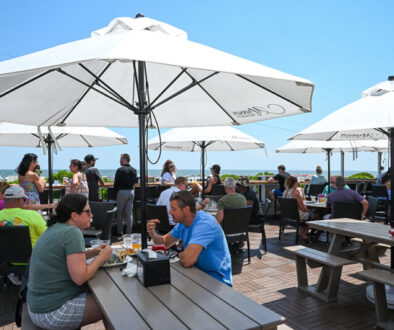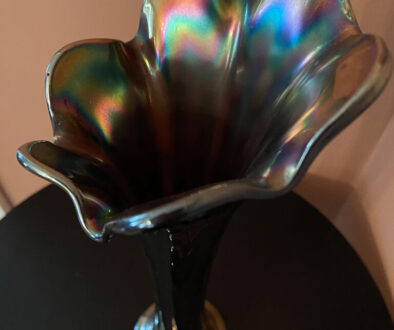To Everything a Season
Nature dictates the menu at Beach Plum Farm, in a farm-to-table dinner series that changes with the harvest
The late chef Anthony Bourdain said good food is “very often, even most often, simple food.” And there may be nothing simpler than vegetables and fruits straight from the vine or tree, just ripe and full of flavor.
For proof, look no further than Beach Plum Farm in West Cape May. Its multi-course farm-to-table dinner series, established in 2016, is based on one thing: what’s out there in the fields, pastures, and garden patches. In the fall, that means carrots and sweet potatoes. In winter, it’s roots and squash. At the height of summer, it’s fruiting crops like eggplant, zucchini, and basil. And from July into late autumn, it’s that crown jewel of Garden State produce, the Jersey tomato.
The farm-to-table concept evokes a bygone era, when life presumably was simpler, the food we ate was less industrialized and messed-around-with, and making supper was almost as easy as pulling it out of the ground.
Of course, anyone who farms for a living knows this is a tough row to hoe. The work is hard and gritty, and subject to factors beyond anyone’s total control, like heat and rain and pests and market factors.
Even so, look at what you get: the harvest.
The Farm Team
At Beach Plum Farm, a small village of farmers reaps this bounty, led by director of agriculture Christina Albert, who left a career in insurance to get back to the garden.
About 10 years ago, expecting her second child, Albert took a more-than-passing interest in the foods she was feeding her family. In a burst of back-to-nature zeal and inspired by documentaries like The Biggest Little Farm and Kiss the Ground, she left her white-collar cubicle and started getting her hands dirty.

First, she launched a community garden in South Philadelphia. Then, she worked as a “garden ambassador” at Whole Foods. After studying at Rutgers and John Hopkins universities as well as the University of Vermont, she landed at Beach Plum, which she calls “the most beautiful farm on the East Coast.” Here, she oversees some 50 acres of farmland that produces 100 organically grown crops as well as livestock, using the principles of regenerative farming.
There’s a lot of buzz right now about regenerative practices, “which really mimic natural systems,” Albert says. The principles start by limiting human interference in the growth cycle with the promise of higher yields and more flavorful foods.
“We use reduced till, trying not to put implements into the ground or turn over the soil all the time,” says Albert. “Instead, we’ll let a field rest, and put in a cover crop, a natural grass like a rye.”
Cover crops, as the name suggests, are sort of placeholders for harvest crops; they help control erosion, increase the soil’s nutrient content, attract pollinators, and provide habitat for good insects. Meanwhile, below-ground, the earthworms do their thing, burrowing into the earth, loosening and oxygenating the soil, and enriching it by eating and recycling organic matter.
Beach Plum Farm first tried regenerative farming about five years ago, and at first it took patience to let a field lay fallow. But, as Albert observes, “the soil was telling us it needed a break.”
Year One involved “rebuilding, sequestering carbon out of the atmosphere back into the soil and letting all those beneficial things happen without disturbance.”
In the second year, “We pasture-raised our poultry across that field. The chickens went wild to see that green grass and would go straight for it to scratch and aerate the earth. They ate the pests and bugs and weeds we don’t want, and more importantly, dropped their manure behind them.”
The next year—pay dirt. “We’re able to take up all of the benefits from the practice.”
After the first rest-and-rejuvenate cycle, Albert and her team put in tomatoes, the farm’s highest value crop, and harvested 11,000 pounds, about 220 bushel baskets, “with zero pest pressure, zero disease pressure, and one fertilizer application. And because it was so successful, we’re rotating that philosophy through all our fields, putting back more than we take, and reaping the rewards. It helps us remain sustainable.”
The farm makes good use of bumper crops: when the fields are overrun with cucumbers, “It’s cucumber tea sandwiches, cucumber water, cucumber this, cucumber that,” Albert says. “When we have a whole lot of zucchinis, well, it’s going to be a lot of zucchini bread, and we’ll be giving the squash away to our cottage guests. We also pickle or freeze produce to use later in the season.”
But all this is just backstory for guests of the farm-to-dinner series. For them, what really matters is what’s on the plate—and the exquisite setting in which it’s served.
The Moveable Feast
The dinners, which take place Tuesday through Saturday evenings, are served family style at long tables. Each course, in heaping enamelware dishes, is passed from hand to hand, encouraging camaraderie and conversation among strangers. Soon, they’re chatting and toasting special occasions (at a recent dinner, among 30 or so glasses were raised to two wedding anniversaries and two birthdays).
“The beautiful thing is, you’re not actually dining in a restaurant, but on a farm, from menus created from the products of that farm,” says Beach Plum general manager Ed Hackett. “It’s a classic style of dining, at communal tables, as people gather to celebrate the harvests.” This is quite literally a moveable feast, he adds: “We set up and break down a restaurant [almost] every day.”
One recurring theme is the phases of the moon, with Tuesday dinners marking the Flower Moon in May, the Strawberry Moon in June, the Buck Moon in July, the Sturgeon Moon in August, the Harvest Moon in September, and so on.
Wednesdays through August 28 are Country Nights. “There’s a big craze with country music right now—thank you, Beyonce,” says Albert. “So, we’re having line dancing, which will be super-fun.” Guests are encouraged to dress the part, in boots, buckles, and big old hats. Children under 10 eat free.
Thursdays are devoted to Argentinian open-fire cooking, in the style of celebrity chef Francis Mallmann, who specializes in Patagonian barbecue. “We’re really preparing and cooking the meal right in front of you,” says Albert.
Fridays are Hook and Harvest dinners, featuring locally sourced seafood. “The tripod of the Cape May economy has always been fishing, tourism, and agriculture and land,” Albert notes. “We’re really blending all three into that meal and supporting other local producers and purveyors.”



On Saturdays, it’s back to the classic farm-to-table model. (On Sundays through September 1, guests can get in on an a la carte barbecue during the day, until 6pm.)
Chef Michael Knights, who came to Beach Plum this spring from Atlantic City’s casino dining scene, takes special pleasure in being closer to the land. His Flower Moon dinner menu was “based on all the things coming into season and flowering at the time: blooms coming off the cilantro, chive blossoms from the garden. I like nasturtium flowers and leaves, and here, I asked for the vines, too, for pickling.” In his previous kitchen, at Council Oak Steakhouse at the Hard Rock resort, “I’d have to order all that. Here, it’s right at hand.”
Menu prep for the week begins on Monday, when he hops into a cart and drives to the back fields “for inspiration.” There, he consults with the farmers to see what’s freshest and best. “That’s something most chefs only dream about.”
Knights brings lots of culinary influences to the table, taking cues from Enrique Olvera, the master of Mexican haute cuisine; Massimo Bottura, the avant-garde auteur of Italian gastronomy; noted American Southern chef Sean Brock; and Dan Barber, a pioneer in the farm-to-table movement. Depending on what’s in season, he can improvise simple but complex and satisfying meals.
“Every dish should have a balance of certain tastes and textures, not all soft, with a little crunch, and a little acid. Each and every one is composed to take you through a well-rounded ‘journey,’” he says.
Weather permitting, diners eat out of doors, in one of several idyllic settings: the hummingbird garden, the butterfly garden, or the rose garden. Fire pits illuminate the grounds as daylight gives way to dusk, then dark, then starlight. If the forecast is uncertain, no worries: the feast moves again, into a crescent-shaped greenhouse called a hoop house, typically used to protect raised-bed crops.
Either way, the result is simple, rustic, and surprisingly refined: at a recent indoor dinner, the tables were dressed with formal white tablecloths under homespun burlap runners; overhead, burlap swags were festooned with strands of lights. Vases of wildflowers marked each place setting—daisies, cornflowers, nasturtiums, and clover in cheerful bunches. More sprays of flowers were stacked atop big oak barrels.
“Our backdrop is already so stunning,” says Albert, “we just put the finishing touches on it.”
Dinner is Served
As guests arrived, they were welcomed with chilled jugs of strawberry lemonade and strawberry rhubarb sangria, which they could spike with gin or a bittersweet orange aperitif. Drinks in hand, they strolled the grounds, which also include a formal parterre garden and a medicinal garden that grows stinging nettles, bergamot, and mint, among other natural curatives.
Servers moved among the crowd, passing hors d’oeuvres: spicy deviled eggs and brioche crostini with chicken liver mousse and sweet-and-tart fig jam. Inside, food and beverage manager Ryan Taylor placed wine bottles in ice-filled buckets. (Dinners are BYOB.)

Then, guests took their seats for more: sweet-tasting spring pea shooters with a dot of creamy mint labneh, and lemon thyme focaccia bread with a delectable lavender honey butter. These starters were followed by roasted beet salad with pickled ramps, smoked goat cheese, and beet greens; coal-fired turnips with carrot puree, spring onions, and turnip salsa verde; and tri-color asparagus with truffle sopprasata and a rich, cheesy pecorino cream sauce, with nasturtium flowers for a touch of bright color.
The main course was a buttery roasted rack of pork with piles of sweet mustard pickled onions and sauteed spinach, succulent and unadorned. “I start it on the grill, because I want that woodfire taste,” says Knights of the entrée. “And I don’t cover up the flavor with seasoning and spices—that would be hiding all the work the farmers do. It’s my goal to really represent them on the plate and let the product shine.”
For protein, the farm raises poultry—pasture-raised chickens, turkeys, and ducks—as well as Hereford pigs, but Knights is mindful of non-meat preferences. A recent vegetarian main dish was a savory blend of mushrooms, mustard pickled onions, and braised rainbow Swiss chard “in a light mushroom broth.”



“If people have dietary restrictions, it’s important to give them the same culinary experience as the person next to them,” he says. “With all this beautiful produce to work with, I’m really working to develop more vegan or vegetarian dishes for the menu.”
The evening ended with a classic Italian dessert; cardamom panna cotta drizzled with Beach Plum Farm honey. The melt-in-your-mouth confection evoked a chorus of sighs from diners. Finally, Taylor introduced the chef, to applause all around.
The experience has made friends of strangers, according to Albert. “We have guests who met at one of our very first dinners who return every year, together, because they struck up such a friendship.”
As in centuries past, farmers live in the past, the present, and the future—reaping in summer what they planted in fall or spring, while making ready for winter. Guests of the holiday dinner series are welcomed by a host, handed a kerosene lantern, then escorted into the woods for a welcome reception around a fire pit, says Albert. After dinner, “We’re definitely going to do some caroling on the back of a hayride.”
In all four seasons, the farm-to-table dinner series is “very relaxed and festive, luxurious but fun, rustic and also elegant. Because that’s our mission statement, really.”



